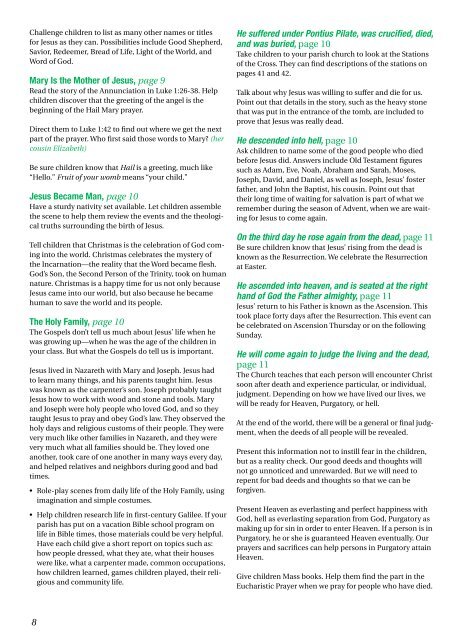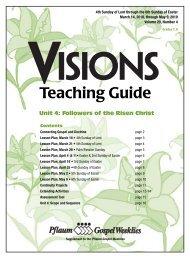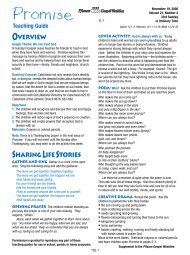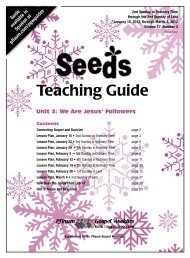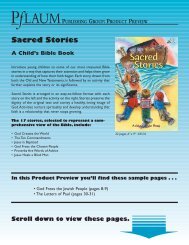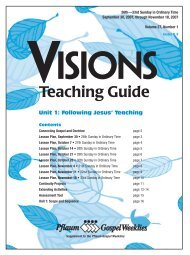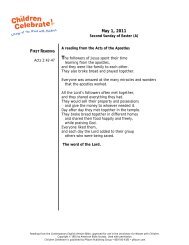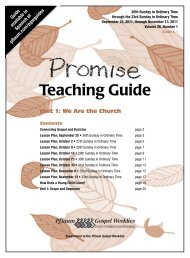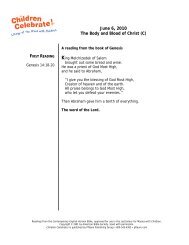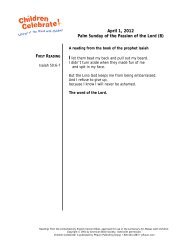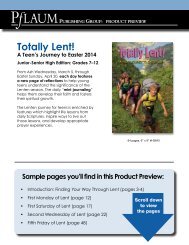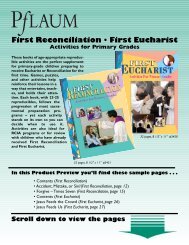Good News - Pflaum Gospel Weeklies
Good News - Pflaum Gospel Weeklies
Good News - Pflaum Gospel Weeklies
Create successful ePaper yourself
Turn your PDF publications into a flip-book with our unique Google optimized e-Paper software.
Challenge children to list as many other names or titles<br />
for Jesus as they can. Possibilities include <strong>Good</strong> Shepherd,<br />
Savior, Redeemer, Bread of Life, Light of the World, and<br />
Word of God.<br />
Mary Is the Mother of Jesus, page 9<br />
Read the story of the Annunciation in Luke 1:26-38. Help<br />
children discover that the greeting of the angel is the<br />
beginning of the Hail Mary prayer.<br />
Direct them to Luke 1:42 to find out where we get the next<br />
part of the prayer. Who first said those words to Mary? (her<br />
cousin Elizabeth)<br />
Be sure children know that Hail is a greeting, much like<br />
“Hello.” Fruit of your womb means “your child.”<br />
Jesus Became Man, page 10<br />
Have a sturdy nativity set available. Let children assemble<br />
the scene to help them review the events and the theological<br />
truths surrounding the birth of Jesus.<br />
Tell children that Christmas is the celebration of God coming<br />
into the world. Christmas celebrates the mystery of<br />
the Incarnation—the reality that the Word became flesh.<br />
God’s Son, the Second Person of the Trinity, took on human<br />
nature. Christmas is a happy time for us not only because<br />
Jesus came into our world, but also because he became<br />
human to save the world and its people.<br />
The Holy Family, page 10<br />
The <strong>Gospel</strong>s don’t tell us much about Jesus’ life when he<br />
was growing up—when he was the age of the children in<br />
your class. But what the <strong>Gospel</strong>s do tell us is important.<br />
Jesus lived in Nazareth with Mary and Joseph. Jesus had<br />
to learn many things, and his parents taught him. Jesus<br />
was known as the carpenter’s son. Joseph probably taught<br />
Jesus how to work with wood and stone and tools. Mary<br />
and Joseph were holy people who loved God, and so they<br />
taught Jesus to pray and obey God’s law. They observed the<br />
holy days and religious customs of their people. They were<br />
very much like other families in Nazareth, and they were<br />
very much what all families should be. They loved one<br />
another, took care of one another in many ways every day,<br />
and helped relatives and neighbors during good and bad<br />
times.<br />
• Role-play scenes from daily life of the Holy Family, using<br />
imagination and simple costumes.<br />
• Help children research life in first-century Galilee. If your<br />
parish has put on a vacation Bible school program on<br />
life in Bible times, those materials could be very helpful.<br />
Have each child give a short report on topics such as:<br />
how people dressed, what they ate, what their houses<br />
were like, what a carpenter made, common occupations,<br />
how children learned, games children played, their religious<br />
and community life.<br />
He suffered under Pontius Pilate, was crucified, died,<br />
and was buried, page 10<br />
Take children to your parish church to look at the Stations<br />
of the Cross. They can find descriptions of the stations on<br />
pages 41 and 42.<br />
Talk about why Jesus was willing to suffer and die for us.<br />
Point out that details in the story, such as the heavy stone<br />
that was put in the entrance of the tomb, are included to<br />
prove that Jesus was really dead.<br />
He descended into hell, page 10<br />
Ask children to name some of the good people who died<br />
before Jesus did. Answers include Old Testament figures<br />
such as Adam, Eve, Noah, Abraham and Sarah, Moses,<br />
Joseph, David, and Daniel, as well as Joseph, Jesus’ foster<br />
father, and John the Baptist, his cousin. Point out that<br />
their long time of waiting for salvation is part of what we<br />
remember during the season of Advent, when we are waiting<br />
for Jesus to come again.<br />
On the third day he rose again from the dead, page 11<br />
Be sure children know that Jesus’ rising from the dead is<br />
known as the Resurrection. We celebrate the Resurrection<br />
at Easter.<br />
He ascended into heaven, and is seated at the right<br />
hand of God the Father almighty, page 11<br />
Jesus’ return to his Father is known as the Ascension. This<br />
took place forty days after the Resurrection. This event can<br />
be celebrated on Ascension Thursday or on the following<br />
Sunday.<br />
He will come again to judge the living and the dead,<br />
page 11<br />
The Church teaches that each person will encounter Christ<br />
soon after death and experience particular, or individual,<br />
judgment. Depending on how we have lived our lives, we<br />
will be ready for Heaven, Purgatory, or hell.<br />
At the end of the world, there will be a general or final judgment,<br />
when the deeds of all people will be revealed.<br />
Present this information not to instill fear in the children,<br />
but as a reality check. Our good deeds and thoughts will<br />
not go unnoticed and unrewarded. But we will need to<br />
repent for bad deeds and thoughts so that we can be<br />
forgiven.<br />
Present Heaven as everlasting and perfect happiness with<br />
God, hell as everlasting separation from God, Purgatory as<br />
making up for sin in order to enter Heaven. If a person is in<br />
Purgatory, he or she is guaranteed Heaven eventually. Our<br />
prayers and sacrifices can help persons in Purgatory attain<br />
Heaven.<br />
Give children Mass books. Help them find the part in the<br />
Eucharistic Prayer when we pray for people who have died.<br />
8


